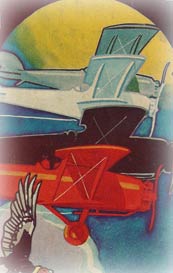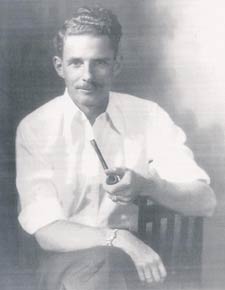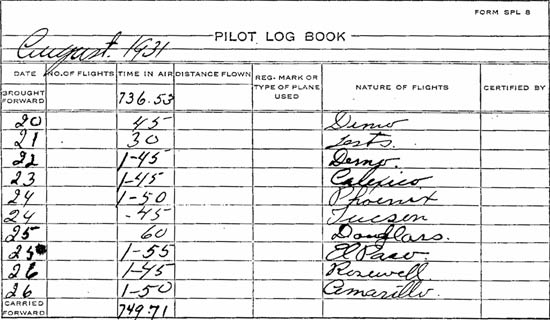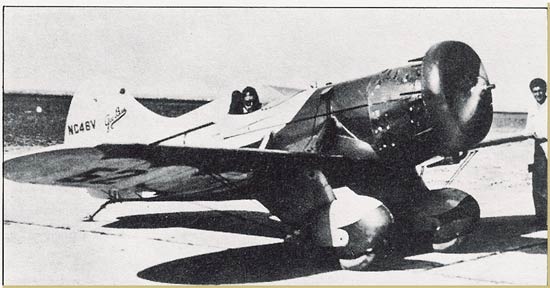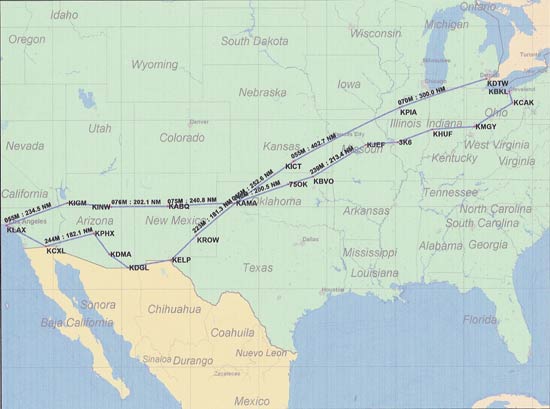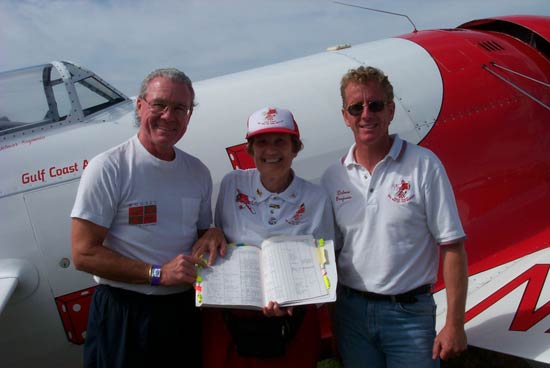|
SIXTEEN DAYS IN THE LIFE...
Zantford Delbert “Granny” Granville visited the
Davis-Monthan Airfield on Monday August 24, 1931 (photo from
p. 114 of the J. Granville reference at right).
He was flying the GeeBee E Model Sportster. His airplane
featured a 110 HP Warner Scarab radial engine. It was Sportster
number 6, registration number NC46V. It was previously owned
by William Sloan and Lowell Bayles, then by Zantford Granville
and Russell Boardman. Bayles and Boardman raced the machine
at different times. The airplane was based in Springfield,
MA.
But what was Granny doing in Tucson? His daughter, Dr. Norma
Granville (cited, right sidebar), and her niece June Granville Dakin, shared with
me the pages from his pilot logbook that record his visit
to Tucson and beyond (his original log lives in the Springfield
Science Museum).
He arrived from Phoenix. He was enroute to Douglas, AZ competing
in the 1931 Transcontinental Handicap Air Derby, which ran
from Santa Monica to Cleveland (the Cleveland Air Races were
held August 29th – September 7th that year). According
to the Aircraft Yearbook for 1932, he did not place in the
top five.
Here is one of the pages from his pilot log that places
him in Tucson. As my transient register states, and his
pilot log corroborates, he was on his way from Phoenix to
Douglas, AZ. Although the Register doesn’t
indicate it, this page from his pilot log suggests he remained
in Tucson overnight and flew to Douglas on the 25th.
He was flying this airplane. The Granville Brothers Aircraft
Company of Springfield became famous for their radically designed
racing aircraft, all named GeeBees. Nine Sportsters, similar
to this one, were built. Depending upon which book you read,
this airplane was either red and white, or green and white
with black pinstripes.
One history of Granville aircraft cites Granny as dropping
out of the derby with abdominal pain that was ultimately diagnosed
as kidney stones. However, the previous and following pages
of his pilot log shows no significant gaps in his travel to
Cleveland! He may very well have been flying while ill.
This is his itinerary derived from his pilot log for August
14-30, 1931. It’s an out and back route from Detroit
to Los Angeles and return to Cleveland, with Amarillo being
a common stop going and returning. The northernmost route
is his travel to the beginning of the derby in Los Angeles.
The southernmost track is his route east from LA to Cleveland
for the handicap event in association with the 1931 National
Air Races. "KDMA" on the chart designates his landing at Tucson.
This 3,861-mile round-trip was quite a 16-day voyage for
the 30 year-old pilot, with barely 700 hours flying experience
(note total hours at bottom of his log page, above), over
mountains and late summer thunderstorms, with compass only,
and no radios! And perhaps kidney stones!
Interestingly, we have another piece of this itinerary, below, in the form of his entry in the Santa Monica, CA (Clover Field) Register for August 18, 1931, six days before he came to Tucson. You can see Granville's signature on the second line down. He had arrived from Kingman, AZ at 3:45 in the afternoon. We know from his pilot log book that it took him two hours and 35 minutes to fly from Kingman to Santa Monica. You can see that leg of his travel on the chart above (KIGM to KLAX).
Santa Monica, CA, Clover Field Register, August 18, 1931 (Source: Underwood)
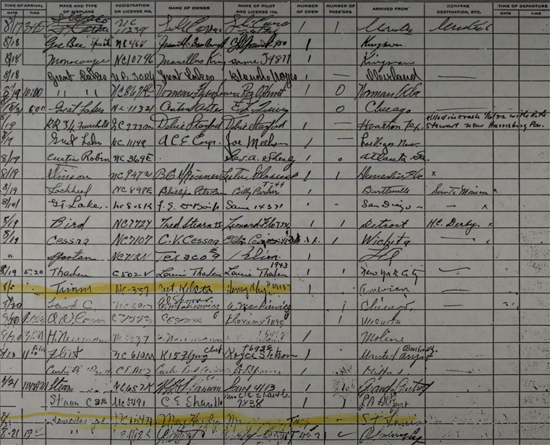 |
ANOTHER LANDING BY A GEEBEE AIRPLANE...
Two Gee Bee aircraft landed at the Davis-Monthan Airfield.
The second was NR2101. It landed on August 5, 1934 piloted
by Joe Lafayette Thomas. What Thomas was doing in Tucson with
the airplane may be devined from the following unabridged
excerpt (relevant phrases in bold) from aerofiles.com.
"R-1, R-2 1932 = 1pClwM; 730hp P&W Wasp T3D1; span:
25'0" length: 17'9" loads: (R-1) 1235#, (R-2) 2087#
v (R-1): 294/260/90. POP: 2 famous record-breakers: R-1 #11
[NR2100] c/n R-1, and R-2 #7 [NR2101] c/n
R-2. In 1933 R-1 had rerated 900hp P&W Hornet. Winner
of 1932 Thompson Trophy (p: James Doolittle, 253mph). Both
planes were destroyed in crashes, but fuselage parts
and landing gears from their remains were used by E. Morgan
Voelker of Tucson AZ to make a 1934 hybrid replica that bore
the original R-2 numbers — it, too, was destroyed, in
a 1935 crash, marking an end to the original barrel-bodies."
This information is further corroborated by a letter sent
to me by his great niece, June Granville Dakin. She wrote,
"As to your inquiry about Joe Lafayette Thomas signing
in at Tucson with a GeeBee NR2101 on 8/5/34, that had to be
the 1933 combination #7 and #11 (often referred to as the
'Hybrid 7'). It came about after the 7 and 11 mishaps. The
#7's wings were used on this longer aircraft. It had to be
this plane (model R1/R2) which was once owned by SARA (Springfield
Air Racing Association). Their pilot, Ray Minor, had slid
off a wet runway while preparing for the 1933 National Air
Races. There was no money nor time to make the necessary minor
repairs, so SARA sought a buyer. Perhaps Mr. Thomas was the
new owner."
Or, perhaps, he was flying it for Mr. Voelker, cited above
by aerofiles. Regardless, see this page
of the register for Thomas' landing information. Why he listed
two passengers is also interesting, since the airplane is
single-place. An image of the airplane can be seen at the
bottom of the page at this link.
REDUCING THE DEGREES OF SEPARATION
BETWEEN THE PAST...
Below, from left, your webmaster, Dr. Norma Granville and
Delmar Benjamin. Dr. Granville and I are pointing to the Davis-Monthan
register entry made by her father, Zantford Granville, 70
years earlier on August 24, 1931. Mr. Benjamin’s airplane,
in the background, is a replica of Gee Bee NR2101, the R-2
model that he flew at air shows between 1992 and 2001.
This photograph was taken July 27, 2001 at Oshkosh, WI.
---o0o---
Dossier 2.1.3
THIS PAGE UPLOADED: 05/05 REVISED: 11/28/06, 09/30/07, 06/24/08, 07/05/09
This page is Google rank #1 as of 07/20/10 if you search for "Zantford Granville."
|

